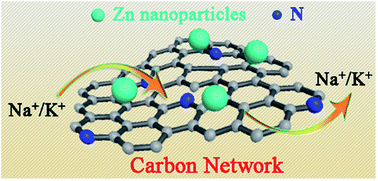Highly dispersed Zn nanoparticles confined in a nanoporous carbon network (ZNP/C) are prepared by directly annealing a Zn-containing metal–organic framework in an inert atmosphere and investigated as an anode material for sodium and potassium ion batteries for the first time. ZNP/C has unique structural features, such as highly dispersed Zn nanoparticles, a nanoporous carbon network and a high surface area, which can efficiently enhance the reactivity, facilitate ion/electron transportation and buffer volume changes, and thus greatly improve its Na/K storage performance. As a sodium ion battery anode, ZNP/C-600 shows a high capacity of 361 mA h g−1 over 100 cycles at 0.1 A g−1, and an ultrahigh capacity of 227 mA h g−1 is sustained after 1000 cycles at 2 A g−1. When employed as a potassium ion battery anode, ZNP/C-600 exhibits a high capacity of 200 mA h g−1 over 100 cycles at 0.1 A g−1, and a stable capacity of 145 mA h g−1 over 300 cycles at 0.5 A g−1. Qualitative and quantitative analyses reveal that capacitance and diffusion mechanisms account for the superior Na/K storage performance, in which the capacitance plays a significant role.

